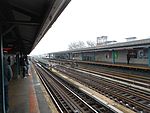Louis Armstrong House
African-American historic house museumsAfrican-American museums in New York CityBiographical museums in New York CityCorona, QueensHistoric house museums in New York City ... and 11 more
Houses completed in 1910Houses on the National Register of Historic Places in Queens, New YorkJazz in New York CityJazz organizationsLouis ArmstrongMuseums in Queens, New YorkMusic museums in New York (state)National Historic Landmarks in New York CityNew York City Designated Landmarks in Queens, New YorkUse American English from June 2022Use mdy dates from June 2022

The Louis Armstrong House is a historic house museum at 34-56 107th Street in the Corona neighborhood of Queens in New York City. It was the home of Louis Armstrong and his wife Lucille Wilson from 1943 until his death in 1971. Lucille gave ownership of it to the city of New York in order to create a museum focused on her husband. The house was designated a New York City Landmark in 1988 and declared a National Historic Landmark in 1976. It now serves as a museum that presents concerts and educational programs, and makes materials in its archives of writings, books, recordings and memorabilia available to the public for research.
Excerpt from the Wikipedia article Louis Armstrong House (License: CC BY-SA 3.0, Authors, Images).Louis Armstrong House
107th Street, New York Queens
Geographical coordinates (GPS) Address Nearby Places Show on map
Geographical coordinates (GPS)
| Latitude | Longitude |
|---|---|
| N 40.755555555556 ° | E -73.861944444444 ° |
Address
107th Street 34-20
11368 New York, Queens
New York, United States
Open on Google Maps







